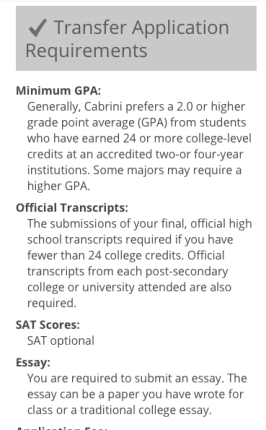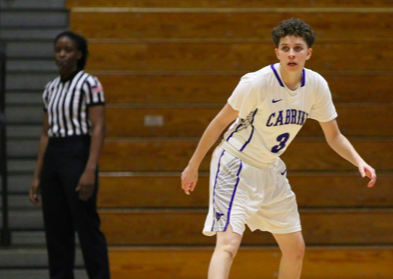Statistics show that over 35 percent of students transfer colleges within their second year enrolled at an institution. According to aacu.org, more than half of students transfer from four-year colleges to two-year institutions. Though transferring may seem beneficial depending on the circumstances of many students, there is more to it than projected. Some students find themselves stuck at schools because their credits may not have transferred or their desired school may not offer them as much financial aid as the institution they currently attend does.
Transfer Students At Cabrini
Here at Cabrini, 30 percent of the current students are transfers. Our transfer application process is rather simple. All one needs is a minimum of a 2.0 GPA (grade point average) and at least 24 credits; qualifying them as an eligible applicant for Cabrini. Students transitioning from two-year institutions have an easier time rolling their credits over to four-year schools. These two-year schools, also known as Junior Colleges, or Ju-Cos, work efficiently with their students to make sure they have the credits needed and an associate’s degree before moving forward.

In an article titled “Community College vs University,” on educationcornener.com, it is said that, “across the country, community colleges have worked to ensure that their associate’s degrees match the general education requirements of most universities, especially local ones. For this reason, it has never been easier for students to transfer credits between the two.” This is evident with Cabrini and Montgomery County Community College as the school accepts many of its transfers from there.
Making sure your hard earned credits follow you
Credits play a major role in transferring. Without enough credits, you may not be eligible to move forward with your transfer application. Every school requires a transcript; a copy of a student’s permanent academic record. Your transcript is like your academic birth certificate and passport all in one. It contains all the final grades you received while at an educational institution. When applying, schools want to make sure you will not be too far behind. They also want to make sure the students past credits will be taken into consideration at the new institution.
Remember, your credits transfer over not your GPA. Your GPA is important though. The first thing institutions see in an applicant is your GPA. This gives them an idea of how good of a student you are. Are you just passing or are you excelling? It helps to have a GPA that will make a student eligible for any scholarships from either the institution they are leaving or soon to be attending. Cabrini University is private Catholic institution. This means Cabrini can decline any credits they feel are not applicable at their university. When leaving a school, it is best that one speaks to their advisor to make sure their credits are equivalent to the ones at the institution they would like to attend.
Can you afford your new institution?
It’s always heartbreaking when you’re almost there, but can’t make the cut. A student has the GPA, credits are transferable, they have recommendation letters, essay is acceptable but financial aid demolishes their dreams. Kirsten Searcy, a sophomore and women’s basketball player at Cabrini experienced this first hand.
“I knew I wanted to transfer spring semester of my freshman year, so I applied for Stevenson University,” said Searcy. “Financial aid was the longest wait, probably like a month. It was two days before move in there and a week before move in at Cabrini and they raised my tuition 15,000 dollars per year.”

Not only did she want to leave for academics, she mentions that it was a “basketball move” too. In situations like this a student has to complete a self-release form before speaking to the other school. Her process lasted longer than a typical transfer student. She also mentions that she had to reserve her spot in classes which was another $300 “wasted.”
“Everything was set up, room and board, I made the team, classes and my meal plan I was just waiting for my official financial aid statement,” said Searcy. “I was in a panic because wherever I went, classes were about to start so I felt like I might have to take a semester off. Since I went here already, I called my coach at Cabrini and she got me back in within three days.”
Searcy stated that transferring was such a long process. She will never do it again because she already has too many credits at Cabrini. Also, she doesn’t want it to end like it did the first time.
Kirsten Searcy’s story is only one of the thousands of stories that did not end in a student’s favor. This can feel like a major blow to a student’s confidence. What if she was not fortunate enough to be re-enrolled and get most of her initial financial aid back at Cabrini?
“I feel like I would have just gone to a community college near home. I want to be a police officer and you only need an associate’s to do that,” Searcy said. “But I still want to obtain my bachelor’s so I would have ended up transferring back into a four-year after Ju-co.”
Is it worth it in the end?
In the end, a student must ask themselves if the transfer was worth it. Before transferring, a student must look at all the aspects that come with being a transfer student. Sometimes credits may not roll over so you have to stay in school longer thus spend more money. The grass is not always greener on the other side. Before transferring, make sure you consult with an advisor on the best alternate opportunities. Be confident that you are ready for the ride and are willing to follow through. Look at what you have in-front of you before you go somewhere else. Compare and contrast everything from room and board, meal plans and financial aid. Always remember that sometimes what you want is not what you need or can afford.


